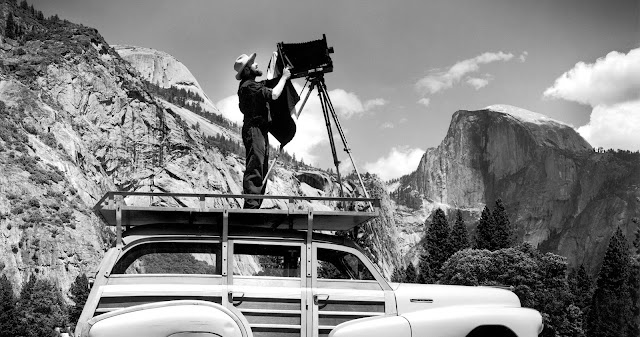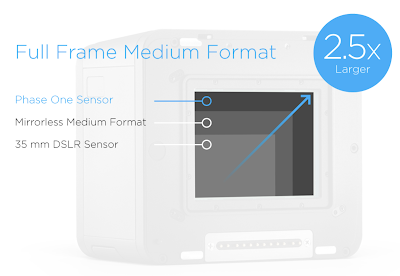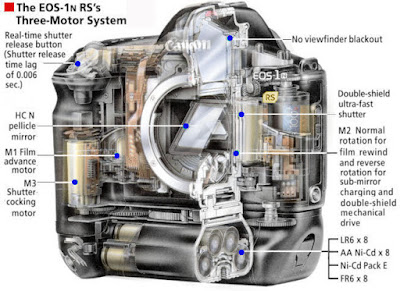Field Cameras vs Studio Cameras
A field system is for sports, wildlife, reportage, and street photography. A studio system is for more methodical use in ideal light situations where portability is less of an issue. As with all dichotomies, the margins are always blurred, but I see this as a good thing. For some, the field is the studio, and Ansel Adams did take his large format camera out into Yosemite. I still find the term "field" vs "studio" camera to be a useful distinction for the purposes of discussion.
The most interesting phenomenon today is that we can squeeze much better quality out of much smaller formats. The basic field camera in everyday use today is the phone camera. Today, M4/3 and APS-C cameras are maturing into remarkably highly resolving field systems.
It used to be that 35mm format was considered a low resolution field system that compromised on image quality for ergonomic gain. You could even buy a disposable 35mm camera at souvenir shops at tourist spots (and nobody touted it as being a "full frame" camera).
 |
| A 35mm format disposable camera. Note that it is not advertised as being "full frame"! |
In the film days, 35mm format was considered a mass market consumer format and editors would refuse to accept submissions to fashion magazines (likewise landscape/architectural submissions) unless it was at least in medium or large format. The only time 35mm format was considered suitable for professional use was professional field use in reportage, wildlife, and sports photography. Part of this related to the fact it was impractical to make fast super telephoto lenses for a medium format system eg a 600mm f/4 lens. Today, as formats grow in resolution, 35mm format is becoming a kind of mini medium studio format, and to keep up with the resolution increase in the format, 35mm lenses have grown to rival film era medium format lens sizes.
The question has to be asked whether the digital equivalent of the field and reportage camera system for professional use is still going to be the 35mm format. The time may eventual arrive for the 35mm format to be gradually retired from field use and put out to pasture into the quiet stable of the studio.
Many will point out that sports and wildlife photographers still extensively use Canon and Nikon 35mm format telephoto lenses. But that may just be a habit that is a legacy of the film era. This is the sort of thing that really questions that dogma. The Fujifilm XF 200mm F2 lens:
In 35mm format terms, it is a 305mm focal length lens.
Now for some bizarre reason, some insist that this lens is the 35mm format equivalent of an F2.8 lens. That is incorrect. If you meter a scene using your light meter so that it would be correctly exposed at F2.8 ISO 200 1/125s on a 35mm format 300mm F2.8 lens and you decided that when shooting the same scene with an APS-C 200mm lens that you would have to correct the aperture for the format by opening up the aperture to F2.0, you will find the photo to be overexposed by a stop.
Next, for some bizarre reason, some people think that the shallower the depth of field the better the photo. The larger the format, for any equivalent field of view and given aperture, the shallower the depth of field, and the better the photo (assuming equal distance to the same subject). It is argued that large format is superior to medium format, which is in turn superior to small formats like 35mm format and APS-C. For these people, depth of field is the enemy of photography, one that we must all collectively fight to eliminate. In this curious world-view, the role of high end gear is to help eradicate every last vestige of depth of field.
There are problems with this assumption. Firstly, depth of field is not the enemy of photography. A good image has a delicate balance of in and out-of-focus areas. And there is no mathematical formula to calculate how much depth of field is too much or too little: it is an aesthetic judgement not a mathematical one. APS-C lenses have plenty of bokeh, especially at longer focal lengths, and this can sometimes become too much. Reducing depth of field ad infinitum to the point of having a 1 micron depth of field or less is just not helpful. Sometimes, being able to open your aperture up to brighten the exposure without sacrificing excessive depth of field can be a saving grace. It is much more forgiving when you have a tiny bit too much depth of field rather than an excessively shallow depth of field.
Secondly, the virtue of ASP-C (and M4/3) format is that it is easier to overbuild the lens to perform better wide open without making the lens too absurdly large and expensive. That means that you can open to maximum aperture without sacrificing on image sharpness. You might point out that Canon white telephoto lenses often perform spectacularly well wide open but there is a cost in the form of weight and price. ASP-C lenses can be made a stop faster and being able to shoot at faster shutter speeds to stop action is often much more important anyway than shallow depth of field when shooting sports and wildlife.
The APS-C format means that you could make a 400mm F2.8 lens that is the equivalent of a 600mm lens in 35mm format terms. Generally 600mm focal length 35mm format lenses are no faster than F4. The fast shutter speeds that you can achieve shooting with an XF 400mm F2.8 is much more important than any reduction of depth of field for field photography, and for ergonomic reasons nobody makes a 35mm format 600mm F2.8 lens anyway.
 |
| The Fuji XF 200mm F2 (2265g) with X-H1 vs the Canon 300mm F2.8 (2550g) with 1d X II. Which would you rather carry all day or check in with at the airport? |
For even longer focal lengths, APS-C is at an even greater advantage. A 600mm F4 APS-C lens would have the same reach as a 35mm format 900mm F4 lens. A 800mm F4 APS-C lens would have the reach of a 1200mm F4 lens in 35mm format. At these sorts of focal lengths, being able to open the aperture to get a faster shutter speed without losing too much depth of field becomes ever more important.
Some might point out that a 35mm format sensor has about a one (or slightly better) ISO stop advantage in low light situations, but that advantage can be lost if the APS-C equivalent lens has a maximum aperture one stop faster anyway. The question becomes how important putting up with greater weight and bulk just to gain a 1-1.5 stop advantage in high ISO performance becomes. As the high ISO performance of APS-C sensors improve, the reason to choose 35mm format will become increasingly tenuous unless low light performance is absolutely critical.
My prediction, based on the ability to squeeze ever better performance out of smaller formats, is that APS-C format may eventually replace 35mm format for serious field use in sports and wildlife with long-throw telephoto lenses. This will increasingly relegate 35mm format to studio photography as a poor photographer's ersatz medium format camera. As the price of medium format sensors comes down photographers will increasing wonder why they would buy into ersatz pseudo-medium format for studio photography when they can get the real thing.
These changes will take many years to take full effect, and come the 2020 Tokyo Olympics, you will still see most photographers on the sidelines shooting Canon or Nikon DSLR systems. However, a super fast Fujifilm X-H2 (with either a stacked or organic sensor) along with a prime lens longer than the XF 200mm F2.0 could mean that some early adopters might be seen on the sidelines in an upcoming Olympic games sooner than we think, though perhaps 2020 might still be a little early.
Conclusion: I predict that over the next decade, due to smaller formats improving in resolution, professional field camera formats will become smaller, and, as a larger format sensors come down in price, studio camera formats will become larger. The age of the 35mm format digital camera being an all-in-one field and studio system is very slowly coming to a close.





Comments
Post a Comment